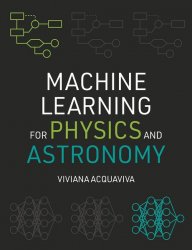Machine Learning for Physics and Astronomy
- Добавил: literator
- Дата: 1-05-2024, 18:45
- Комментариев: 0
 Название: Machine Learning for Physics and Astronomy
Название: Machine Learning for Physics and AstronomyАвтор: Viviana Acquaviva
Издательство: Princeton University Press
Год: 2023
Страниц: 281
Язык: английский
Формат: pdf (true)
Размер: 61.0 MB
A hands-on introduction to Machine Learning and its applications to the physical sciences.
As the size and complexity of data continue to grow exponentially across the physical sciences, Machine Learning is helping scientists to sift through and analyze this information while driving breathtaking advances in quantum physics, astronomy, cosmology, and beyond. This incisive textbook covers the basics of building, diagnosing, optimizing, and deploying Machine Learning methods to solve research problems in physics and astronomy, with an emphasis on critical thinking and the scientific method. Using a hands-on approach to learning, Machine Learning for Physics and Astronomy draws on real-world, publicly available data as well as examples taken directly from the frontiers of research, from identifying galaxy morphology from images to identifying the signature of standard model particles in simulations at the Large Hadron Collider.
What Is Machine Learning? To the best of my knowledge/ability to explain, I would say that it’s the process of teaching a machine to make informed, data-driven decisions. Examples of such decisions include recognizing and characterizing objects based on similarities or differences, detecting patterns, and distinguishing signal from noise. In many ways, the boundaries and definition of Machine Learning as a discipline are fluid, and so far, it’s often been approached without a scientific spirit of inquiry. But it is my opinion that this process should be subject to the same level of rigor and testing that any scientific investigation needs to endure.
In this book, we will explore many ways to build, test, understand, and break Machine Learning models. We can select a training set for each model, which contains seven points from the learning set. In Scikit-learn or sklearn, the Python package for Machine Learning that will be our main software library throughout the book, we can do this easily by using the auxiliary function train_test_split and fixing the random seed for reproducibility.
Introduces readers to best practices in data-driven problem-solving, from preliminary data exploration and cleaning to selecting the best method for a given task
Each chapter is accompanied by Jupyter Notebook worksheets in Python that enable students to explore key concepts
Includes a wealth of review questions and quizzes
Ideal for advanced undergraduate and early graduate students in STEM disciplines such as physics, computer science, engineering, and applied mathematics
Accessible to self-learners with a basic knowledge of linear algebra and calculus
Slides and assessment questions (available only to instructors)
“Machine Learning for Physics and Astronomy covers the essential concepts of Machine Learning algorithms in detail, with accessible examples and practical applications.” -Claudia Scarlata, University of Minnesota
“A wonderful introduction to the field. Acquaviva uses an engaging, conversational tone that breaks through the algorithmic details and welcomes the reader into the marvelously expansive world of Machine Learning.” -John Bochanski, Rider University
Contents:
Скачать Machine Learning for Physics and Astronomy
[related-news] [/related-news]
Внимание
Уважаемый посетитель, Вы зашли на сайт как незарегистрированный пользователь.
Мы рекомендуем Вам зарегистрироваться либо войти на сайт под своим именем.
Уважаемый посетитель, Вы зашли на сайт как незарегистрированный пользователь.
Мы рекомендуем Вам зарегистрироваться либо войти на сайт под своим именем.

